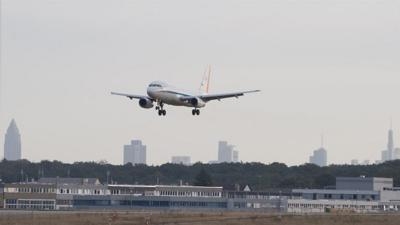Three Days Of Flight Tests Conducted Using A320 Research Aircraft
Reducing aircraft noise over residential areas while saving fuel is the goal of a joint research project being conducted by the German Aerospace Center (Deutsches Zentrum für Luft- und Raumfahrt; DLR) and the Umwelt- und Nachbarschaftshauses (UNH) in Kelsterbach. The tests of the Low Noise Augmentation System (LNAS), a pilot assistance system for noise-optimized landing approaches, are being conducted using an A320 Advanced Technology Research Aircraft (ATRA) at Frankfurt Airport.

During landing – generally the most labour-intensive phase of a flight – it is often difficult for pilots to select the optimum times at which to extend the flaps and lower the landing gear so that the greatest possible part of the landing approach can be conducted in quiet, fuel-efficient manner, with the engines at idle. As a result of a doctoral research project at the DLR Institute of Flight Systems in Braunschweig, an assistance system has been developed that shows the pilots a flight deck display of the points at which they need to carry out certain actions to create the optimum low-noise descent in line with the approach controller's instructions. Previously, the system has been successfully tested in a simulator and in initial research flights with no surrounding air traffic.
Weather conditions, poor visibility, the weight of the aircraft and instructions from air traffic control each have a different effect on every landing. DLR researchers want to find out how these variable influences affect the new assistance system and how professional pilots respond to the system. For this reason, pilots from several airlines have taken turns sitting alongside a DLR test pilot on ATRA's flight deck and make approach flights to Frankfurt – sometimes with the assistance system, sometimes without. The test flights are being coordinated with the German air traffic control service (Deutsche Flugsicherung; DFS) and Frankfurt Airport.
Before the actual flight tests, extensive trials were carried out in the DLR Air VEhicle Simulator (AVES). "We are delighted to now be able to send the newly-developed assistance system for a real-life check at the busiest airport in Germany," says Stefan Levedag, Head of the DLR Institute of Flight Systems. "An important step in the development process is gathering the impressions and experiences of experienced airline pilots with the new system in the demanding operational environment at Frankfurt Airport, with its high volume of traffic." Another advantage is the numerous noise measurement stations that have been set up around the airport. These can be used to locally quantify the noise reduction effect of the optimised approaches.
The UNH is supporting the project with a total of 560,000 euros (approx. $627,000). Improving the noise situation for the Rhine-Main region through active noise abatement is a top priority for the Airport and Regional Forum (Forum Flughafen und Region; FFR).
"In collaboration with DLR, we have succeeded in continually advancing new, innovative processes. The LNAS project has a very special appeal because it enables noise to be reduced and kerosene to be saved at the same time," says Günter Lanz, Managing Director of UNH. "In addition to processing data and carrying out monitoring, the main purpose of our work is to commission scientific studies and research projects and thus fill factual and expertise gaps. Hence, we want to provide new impetus for the debate concerning aircraft noise and give innovative ideas a chance." The results of the project will be presented at the 4th ICANA 2016, the International Conference on Active Noise Abatement, in November 2016 and subsequently published.
The program includes a total of five test flights of five hours per day, including take-off, approach and go-around using the northwest runway at Frankfurt Airport. During each test flight, the flight captain – a DLR pilot – will be accompanied by four pilots who will each carry out two approaches in normal operational conditions – once with and once without the pilot assistance system. The sequence of pilots and use of the system has been arranged so that any learning effect is excluded.
In the test flights, the altitude and speed profiles of conventional approach flights will be investigated in terms of their potential for reducing noise, fuel consumption and flight time within the constraints of real flight operations.
In addition to improvements in terms of noise and precision, error-free functioning of the prototype in actual flight operation is expected from the start. At the same time, a high level of acceptance by the pilots is sought.
(Image provided with DLR news release)
 Airbus Racer Helicopter Demonstrator First Flight Part of Clean Sky 2 Initiative
Airbus Racer Helicopter Demonstrator First Flight Part of Clean Sky 2 Initiative Diamond's Electric DA40 Finds Fans at Dübendorf
Diamond's Electric DA40 Finds Fans at Dübendorf ANN's Daily Aero-Term (04.23.24): Line Up And Wait (LUAW)
ANN's Daily Aero-Term (04.23.24): Line Up And Wait (LUAW) NTSB Final Report: Extra Flugzeugbau GMBH EA300/L
NTSB Final Report: Extra Flugzeugbau GMBH EA300/L Classic Aero-TV: 'Never Give Up' - Advice From Two of FedEx's Female Captains
Classic Aero-TV: 'Never Give Up' - Advice From Two of FedEx's Female Captains



